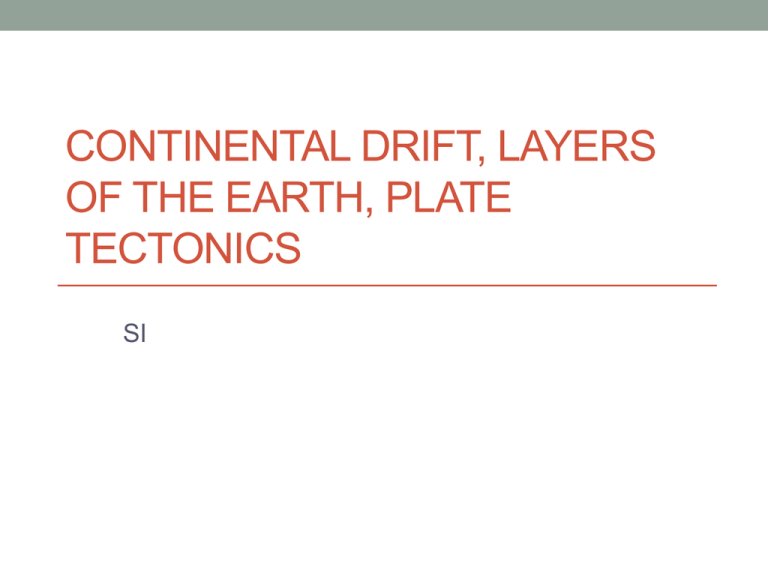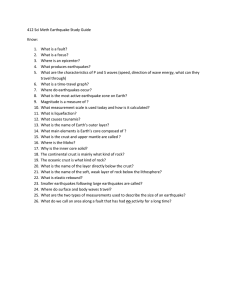Plate Tectonic Notes
advertisement

CONTINENTAL DRIFT, LAYERS OF THE EARTH, PLATE TECTONICS SI I. Earth’s Interior A. Layers of the Earth 1. Crust: thin and solid outermost layer of Earth above the mantle. a. Continental crust is less dense and thicker than oceanic crust. layer of rock between the Earth’s crust and core a. Denser than the crust b. Outermost part is solid and rigid, but as you move closer to the core, the mantle becomes soft and easily deformed (like gum) 2. Mantle: c. Crust and uppermost solid mantle called the lithosphere d. Soft part of the mantle is called the asthenosphere 3. Outer Core: Liquid metal composed mainly of iron and nickel 4. Inner Core: Solid metal composed mainly of iron and nickel B. As you travel from crust into the core, the temperature increases from 375oC at the crust to over 6000oC in the inner core C. Thermal Energy Transfer 1. Material and energy moves within the Earth as a result of convection currents(hot material rises and cool material sinks back to the core) II. Continental Drift A. Theory that Earth’s surface is made of large movable plates 1. Alfred Wegener was a German scientist who first proposed the idea that the continents of the Earth were once one large supercontinent a. Called this supercontinent Pangaea B. Early evidence for Continental Drift 1. Fossils: Mesosaurus fossil found in Brazil and western Africa a. Not likely to have swam between continents 2. Shape of continents :seemed to fit together like a puzzle 3. Glacial deposits: same deposits in United States are also found in Greenland and Western Europe 4. Rock structures : similar ones are found on different continents 5. Migration patterns of animals have not changed since it was supercontinent C. Recent evidence for Continental Drift (Sea-floor spreading) 1. Magnetic polarity bands near mid-ocean ridge a. Alternating magnetic bands, on new ocean floor 2. Age of rocks relative to the mid-ocean ridge: the farther away from the mid-ocean ridge, the older the rock Plate Tectonics • Theory that the Earth’s lithosphere is broken into plates that move over the asthenosphere • Replaced the theory of Continental Drift Plate Tectonics continues • Lithosphere is divided into 7 major plates and several smaller plates called tectonic plates • How do tectonic plates move? Types of Boundaries 1. Divergent •Plates are moving apart •New crust is created •Magma is coming to the surface Continental crust forms rift valley Oceanic crust forms mid-ocean ridge Sea-Floor Spreading – (Divergent) Types of Boundaries 2. Convergent •plates are coming together •crust is being destroyed in the mantle 2 oceanic plates or oceanic + continental subduction 2 continental plates mountain range (forms ocean trench) Types of Boundaries 3. Transform •plates are slipping past each other •crust is not created or destroyed Stress builds up Stress is released earthquake Common Events at Plate Boundaries: Volcanoes • Do not occur at convergent boundaries of continental to continental crust or transform boundaries • Geysers – water heated by magma that comes to the Earth’s surface Volcanoes-”Ring of Fire” Where 80% of the world’s Earthquakes occur Common Events at Plate Boundaries: Earthquakes Earthquake Effects: Tsunami A tsunami is a giant wave or sequence of waves produced by large water displacements. These are most commonly caused by underwater earthquakes. Tsunamis can be destructive long distances from their sources. Then how can there be volcanoes that are not on plate boundaries? = Volcano ? Hot Spots •A hot spot is an area of persistent volcanic activity that comes from unusually hot areas of the mantlecore boundary. •Hawaii, Iceland, and Yellowstone (geysers) are examples of hot spots. V. Earthquakes A. As plates move past each other, pressure builds up and eventually the stress becomes so great it causes the rock to crack 1. Focus: exact point inside Earth when an earthquake originates 2. Epicenter: point on Earth’s surface directly above an earthquake’s focus B. Energy is transferred by waves 1. Longitudinal waves (P Waves): Move faster through rock, so first waves to reach recording stations 2. Transverse waves (S Waves): Move more slowly, so arrive second to the recording station 3. Surface waves: seismic waves that can only move through solids C. Seismograph: machine that records the movements produced by an earthquake 1. Use seismographs to investigate the Earth’s interior 2. Differences in velocities of the waves indicate the type of material the waves travel through a. Scientists constructed the model of Earth [Fig. 19, p.712] D. Richter Scale: a scale that expresses the magnitude of an earthquake 1. Range from 2.0 to 10.0 magnitude 2. No earthquakes have ever been recorded at 9.0 or 10.0








